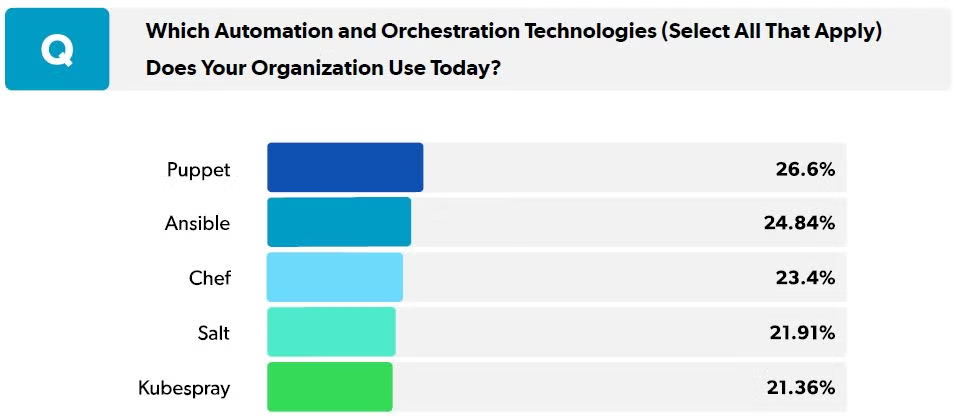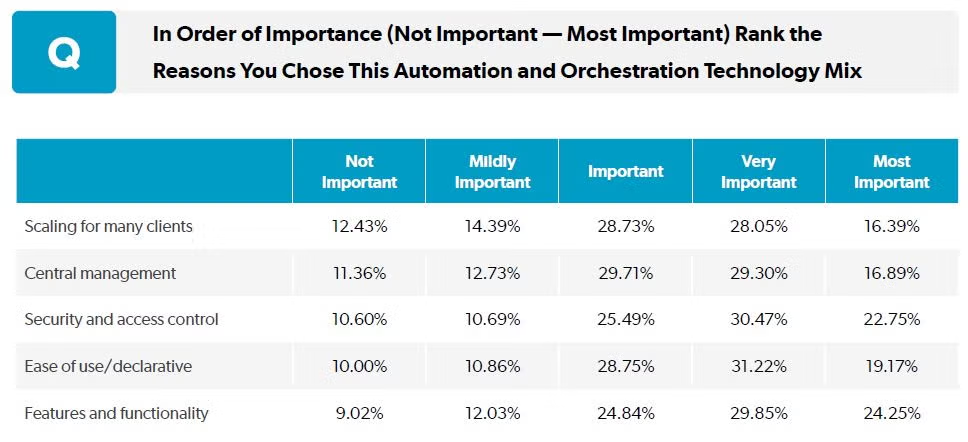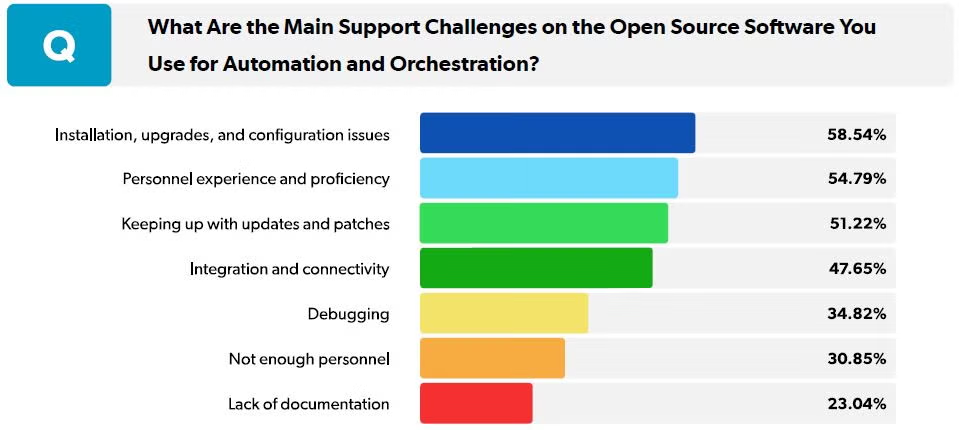Editor's Note: The 2025 State of Open Source Report is now available.
Over the last few years, DevOps has been top of mind for organizations across all industries. This is evident in organizations moving and advancing DevOps initiatives, and the veritable boom of open source DevOps software. But which technologies are most used today? And which ones are primed for success going forward?
In this blog, we provide data from our 2022 State of Open Source Survey that helps to answer those questions, including the top open source automation and orchestration technologies of 2022, the criteria teams use to select these technologies, and common challenges they encounter when adopting them.
About Our 2022 Survey
In our 2022 State of Open Source Survey, we narrowed the scope to only automation and orchestration, listing only the most popular open source automation and orchestration tools, and leaving open source Continuous Integration (CI) and Continuous Delivery/Deployment (CD) tools in a separate category. For the purposes of our survey, we considered Puppet, Ansible, Chef, Salt, Kubespray, Terraform, Rancher, and Zabbix to be automation and orchestration technologies, and GitHub Actions, GitLab, Jenkins X, Jenkins, Spinnaker, Travis CI, Tekton, and Zuul to be CI/CD tools.

Perhaps owing to the much larger number of responses in this year’s survey, we have some major year over year changes. For example, last year 50% of the respondents indicated that they were not using any of the listed tools. This year, it went down to only 16%. Like everything else in open source, there is significant growth and adoption of DevOps related tooling.
Salt also had a significant increase from last year, jumping up from 7% to 22%. Puppet is the other highlight, surpassing Ansible in the last 12 months in our respondent’s usage selection.
Back to topThe Top 5 Open Source Automation and Orchestration Technologies of 2022
The top 5 open source automation and orchestration technologies of 2022 — according to data from our 2022 State of Open Source survey — are as follows:
1. Puppet
Our 2022 survey found Puppet as the most adopted technology among automation and orchestration technologies with 26.6% of respondents using the software. This marks over 10% growth from our previous survey, in which Puppet received 16% and was ranked as the third most popular automation or orchestration technology behind Ansible and Terraform.
2. Ansible
Ansible was the second most adopted automation and orchestration technology in our 2022 survey, with 24.8% of respondents reporting use of the software. This was flat compared to our previous report, which found 24% using Ansible.
3. Chef
In third, we found 23.4% using Chef as their automation and orchestration tool of choice. Like Puppet, Chef saw double digit percentage growth — showing a 10% increase in use since our last survey.
4. Salt
In fourth, and representing the second-highest percentage growth compared to our last survey, was Salt. Salt improved from 7% to 21.9%, showing a strong growth trajectory for this open source automation and orchestration technology.
5. Kubespray
In fifth with the highest precentage growth compared to our previous data was Kubespray. Kubespray represented 5% of respondents in our previous survey, and in 2022 that number grew to 21.4%.
Back to topWhy Teams Choose Open Source Automation and Orchestration Tools
Teams choose open source automation and orchestration tools for a variety of reasons, but in our 2022 survey, we found a few reasons that organizations found especially important.

When looking at these responses based on organization size, respondents from small organizations rated scalability as “not important” to a significantly larger degree than medium and large organizations. At the same time, respondents from small organizations selected scaling for many clients as the “most important” factor.
From this, we can infer that some small organizations are growing or have plans for growth, and scaling the number of clients is a key factor in the selection of open source software for automation and orchestration.
Back to topTop Support Challenges for Open Source Automation and Orchestration Technologies
There are a number of challenges that organizations face when using software -- open source or proprietary. However, for open source automation and orchestration technologies, there are a few unique challenges that teams face. In our 2022 survey, we asked teams to weigh in with their biggest challenges and found some interesting results.

Installation, upgrades, and configuration issues were selected as the top support challenge at 58%, which is a high percentage when compared with the top support challenge for other open source technologies. As with all DevOps tools, one of the challenges is that developers have to work with unknown or new tooling, and get stuck during complex installations and configurations. Not every organization has DevOps teams with operations experts in the different automation and orchestration tools.
Personnel experience and proficiency ranked as the number two challenge with 55%. Similar to other technologies, keeping up with updates and patches ranked third with 51% of respondents.
Back to topFinal Thoughts
One of the biggest takeaways in this year's report regarding open source automation and orchestration trends was that adoption of open source technologies within this space has become much more prevalent. As noted above, our previous survey found 50% not using any of the listed open source automation and orchestration technologies. In our 2022 survey, that number dropped to just above 16%.
This number speaks to not only the widescale adoption of these technologies across organizations of all sizes, but the improvement and addition of new technologies that widen use cases and make their benefits more accessible. That said, adoption doesn't automatically equal success. As noted above, we found many organizations that adopted these open source technologies struggling with installation, configuration, upgrades as well as access to personnel skilled in their deployed technologies.
Get Support for Your Open Source Automation and Orchestration Software
With OpenLogic expert technical support in your corner, your team can rest easy knowing they're deploying their OSS the right way, and have someone to help if they get it wrong. Talk to an expert today to learn more about how we can support your open source automation and orchestration software.